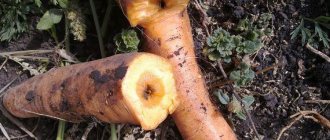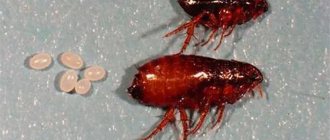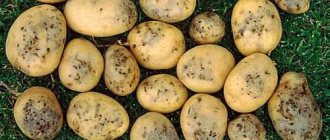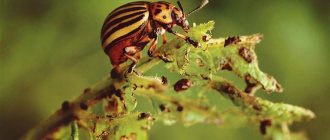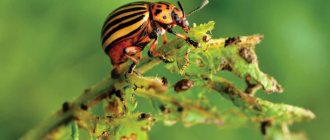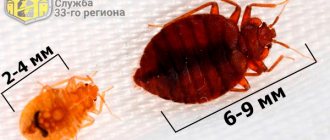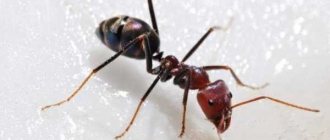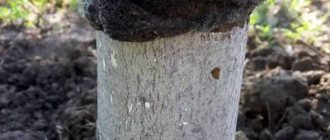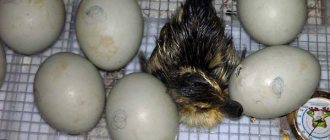Wireworms are the larvae of all pests that belong to the genus of click beetles (Elateridae). In appearance, they are worms, sometimes reaching 45 mm in length, with powerful nodules and a body as hard as wire.
Stages of development:
- May-July: beetles (imago) lay eggs (1st stage).
- After 20 days, larvae appear from the laid eggs (stage 2 lasts from 2 to 5 years).
- After at least 24 months of life (July-August), the larva becomes a pupa (3rd stage - 14-21 days).
- August-September: the pupa turns into a beetle and overwinters in a cradle.
- From April next year, the beetles migrate, looking for conditions favorable for reproduction.
The larvae live in the top layer of soil (found at a depth of up to 15 cm), and before autumn frosts they burrow to a depth of up to 60 cm.
What does a wireworm look like and why is it dangerous?
A wireworm is the larva of a click beetle that looks like a yellow, brown, or dark red worm. It has its own distinctive features:
- oblong body;
- length up to five centimeters;
- lives about three years;
- small hairs on the body;
- there are antennae;
- six legs with claws.
There are about ten thousand species of click beetles. And only a few dozen lay harmful larvae. The most dangerous for potatoes are:
Advertisements
- Melanotus;
- Agriotes;
- Selatosomus.
How does a larva live?
Wireworm appears in potatoes at any stage of plant development. It eats roots, stems and young shoots, moves inside root crops, and gnaws out tunnels. Damaged tubers, remaining in the soil, are colonized by fungi and bacteria. They rot quickly and their presentation suffers. Due to this, 80 percent less harvest is harvested in the fall.
The beetle larvae overwinter in the soil of the garden, and in the spring, after hibernation, they begin to eat crops, so the situation will repeat itself the next year. They live in the ground for up to five years, provided the temperature is favorable.
The click beetle arrives in April and lays its eggs everywhere - about 200 eggs per season. Females hide them in secluded places - under earthen lumps and plant remains, in cracks. After a month, the hatched larvae feed on rotted grass. During this period, they do not damage garden crops.
Larvae at the age of two years grow up to 30 mm and look like strong worms with bodies divided into segments. Their color changes from yellowish to brown, and their body hardens over time. They cause the maximum threat to potatoes and can chew through the hardest tuber thanks to their powerful jaws. No matter how hard the gardener tries to crush the worm, he is unlikely to succeed.
The parasite loves an acidic environment, moist soil and dense grass thickets. The presence of nutrients in the soil creates comfortable conditions for its existence. It is omnivorous and is capable of turning a garden into entire colonies of larvae of different ages.
When turning over on its belly, it makes a sound like a click. This happens due to the impact of a special process at the base of the elytra. This mechanism allows you to throw your body up, turn over and land on the surface with your feet. It is quite difficult to confuse the wireworm with other parasites.
A little about repellent plants
If a gardener is faced with the question of how to deal with wireworms, it is worth remembering some secrets. For example, they do not like the smells of such plants:
- green manure, especially mustard, lupine, phacelia, rapeseed, alfalfa, rapeseed, sweet clover, buckwheat;
- some legumes, such as beans, peas, vetch, beans, planted between rows in the affected area;
- Among flower crops, dahlias and marigolds are not favored.
You should not sow rye and other cereals nearby, because adult insects like to feed on the leaves of plants of these families. The roots of wheatgrass, sedge, and millet are also considered a favorite delicacy of worms, with which they will have to wage a merciless fight.
How to detect wireworms on the site
When starting the fight against wireworms, it is worth learning about the primary signs of crop damage:
- freshly dug tubers revealed cavernous holes of narrow diameter and small depressions on the dark-colored skin;
- wilted and diseased bushes appeared;
- both groups of parasites and individual specimens were found on the site;
- wireworm appeared in corn, carrots, radishes, melons or watermelons.
The larvae usually damage separately growing bushes; they rarely migrate throughout the entire garden bed. It is very difficult to get them. They are usually able to burrow several meters deep into the ground. During the period of activity they are found in the upper layers of the soil. During drought, the wireworm intensively gnaws through potato tubers, and during the rainy season it is relatively inert.
How to deal with wireworm on potatoes
Many summer residents are interested in how to get rid of the parasite on the site and prevent its spread. Dealing with the pest is quite difficult, despite the fact that there are many methods of controlling wireworms. It is rare that anyone manages to destroy it completely. However, it is realistic to reduce the population to a minimum size in order to suffer insignificant damage.
The following actions are effective:
- eliminating plant residues during autumn cleaning of beds;
- processing potatoes before planting using natural fertilizers;
- digging up the soil before frost;
- periodic loosening of the soil (weekly in May and June);
- compliance with crop rotation (it is better to plant potatoes where legumes have been growing for 2-3 years);
- attracting titmice and starlings to the garden;
- use of green manure plants;
- planting marigolds and calendula near the plantings;
- decreasing soil acidity.
Advice
Experienced gardeners do not advise leaving potato tops on the plot, otherwise the click beetle will overwinter in them and again begin to spoil the plants. If the tops have withered, the bush must be dug up urgently. Perhaps the pest is still there. It must be destroyed, as it can spread throughout the entire garden.
Parasites live both in the soil and on food supplies. Therefore, it is important to remove spoiled tubers in a timely manner.
Timely weed control and proper processing increase the chances of getting rid of click beetle larvae. It is important that neighbors in the country also take preventive measures, otherwise the pests will return again. You should not bring soil from another neighboring site, because it may be contaminated.
Brief description of the pest
The adult individual (click beetle) is small in size, reaching only 1.5-2 cm in length. Its distinctive feature is that the insect is capable of making a characteristic click when turning over. During the summer, the female is capable of laying an average of 100-150 eggs in the soil, from which the larvae of the harmful wireworm emerge.
2-4 year old worms are characterized by a segmented body with numerous legs. Their length can vary up to 2-3 cm, and adult specimens have a hard shell of chitin, which does not allow them to simply be crushed by hand.
If you look at a photo of a wireworm, you can see that in appearance they resemble small pieces of wire (which is why they got that name).
Baits and traps against wireworms
Many gardeners prefer to fight wireworms with folk remedies. They are available and safe. Catching pests gives certain results. The more beetles are caught in traps, the fewer offspring they will produce. The following methods are usually used:
- Traps will help remove wireworms from potato fields. It is necessary to plant lettuce or corn between the rows of vegetables. Pests love to prey on their roots. Growing shoots are torn out along with the larvae.
- In May and June, the soil is weeded and loosened. The eggs and larvae of the click beetle end up on the surface and become defenseless against birds and the sun's rays.
- Straw or hay are suitable as bait. In different places of the site, small depressions are made in the ground and rotted grass and hay are placed in them. Then pour some water into the hole and cover it with a plank. After two days, they look into the trap and remove the accumulated pests. Potato tubers are also used as bait. They are placed in a recess and wait until the wireworms are ready to feast on the vegetable.
- In the spring, planks or pieces of film are laid out in the garden, which are pre-lubricated with sugar syrup. Insects flock to the sweet smell and can no longer fly away. This way they can be easily destroyed.
- Potato pieces are strung on a fishing line and placed in a shallow groove, covered with earth. After four days, the “catch” is collected and scalded with boiling water. Caught wireworms are used as food for birds.
other methods
They fight wireworms in a potato field using available means. Among them:
- Potassium permanganate. Two grams are diluted in a bucket of water and the soil is watered with the prepared solution.
- Eggshell. It is crushed and scattered over garden beds.
- Onion peel. During the winter, they save as many onion peelings as possible, and during sowing of potatoes, they put them in each hole.
- Mineral salt. It is scattered over the soil surface once every five years. After this, the earth is dug up.
- Wood ash. Throw it into the hole at the planting stage and during the growth of shoots on the surface of the earth.
- Kvass grounds. Kvass is prepared and the remaining grounds are placed in a stocking. Add a little yeast and a piece of bread to it. The stocking is buried in the ground so that its upper part remains on the surface. In 2-3 days, wireworms will gather in it. All that remains is to get them out and poison them.
- Mustard. It is planted between potato beds and a little poured into the hole when planting the crop.
Herbal tincture
There are other folk remedies for pest control. It is useful to use an infusion based on well-known plants:
- two hundred grams of dandelion;
- half a kilo of nettles;
- one hundred grams of celandine;
- two hundred grams of coltsfoot.
All components are crushed and poured into 10 liters of warm water. After three days, the beds are treated with a solution. Then they take a break for seven days and repeat the procedure.
People's secrets
In order to completely survive the wireworm from their garden, the owners divide the plot in half. One part is sown with rye (peas, mustard, buckwheat), and the other is used for planting (rows of crops are “diluted” with beans, dahlias, marigolds).
The next season, the same planting principle is repeated, only the area of the sown part is planted with garden crops (the parts are swapped: where they were sown, they are used for a garden). Some gardeners throw beans into the holes with potatoes to scare away the wireworms from the tubers.
Fighting with folk remedies is not only safer, but also much more effective, since the methods can be used regardless of the phase of crop development (flowering, ovary formation, period before harvest).
Biological and chemical preparations against wireworms
If natural and agricultural means do not give the desired result, you should resort to the use of special preparations for wireworms. They are used strictly in accordance with the instructions. It is forbidden to increase the indicated dosage.
To eliminate larvae, the soil is treated with the following means:
- "Thunder-2";
- "Bazudin";
- "Diazinon";
- "Provotox";
- "Trap";
- "Initiative";
- "Zemlin";
- "Vallar";
- "Karate";
- "Decis".
Let's look at the most popular drugs against the click beetle.
Nemabact
The bioinsecticide “Nemabakt” is especially popular. It is absolutely harmless to people and animals and is valid for two years, provided that the rules of use are properly followed. The solution cannot be prepared in advance and stored. Opened packaging is used immediately.
Penetrating the click beetle, Nemabact leaves behind a bacterium that destroys the insect’s body from the inside. Gardeners recommend using the product with a special “Protection” primer.
Prestige
An effective remedy against wireworms is the drug “Prestige”. It is produced by a German company complete with a measuring cap. According to the instructions, “Prestige” is diluted with water and the bushes are treated with the solution. The procedure is carried out before and during planting of tubers. Before planting, the potatoes are sprayed and thrown into the prepared recesses.
To protect the seedlings, the rhizomes are kept in solution for about eight hours, after which they are planted in the ground. The disadvantages of this product include the high price of the drug. But it has several clear advantages:
- high efficiency;
- gentle impact on crops;
- additional extermination of fungi and other insects;
- stimulation of shoot growth.
When using Prestige, it is important to follow safety precautions.
Provotox
The effective product “Provotox” shows good results due to its specific focus. It is specially developed for wireworms and affects the nervous system of the pest. The granules are distributed over the soil surface, and when the insects eat the bait, they become paralyzed and die.
Compared to its analogues, Provotox is quite affordable, not as toxic and does not pollute groundwater. It is easily removed from the soil over time.
Bazudin
"Bazudin" is a popular universal remedy for protection against wireworms and aphids. It works for six weeks just a few hours after application to the soil.
"Bazudin" is non-toxic and easy to use. It has a pungent odor and requires the use of special gloves and safety glasses.
Such products are effective for 40-45 days. After this time, it is recommended to reapply the medications. They are sprinkled near the root and walked over each bush with a hoe, mixing with the soil. After 45-50 days, the procedure is repeated.
The following products are toxic to beetles:
- ammonia water;
- nitrogen fertilizers;
- potassium chloride (it is added during digging);
- potassium permanganate.
An effective composition can be prepared as follows:
- Five kilograms of superphosphate in granules are scattered in a thin layer on a polyethylene film.
- Then take one milliliter of “Karate” or two milliliters of “Fastak” and add the product to a solution of water (800 ml) and acetone (200 ml).
- The prepared mixture is sprayed with superphosphate and left to dry.
- The resulting preparation is scattered over an area of 100 square meters.
Warning
The use of insecticides gives quite good results. However, they should not be abused. Wireworms become more resistant to drugs over time. In addition, frequent use of chemicals will not benefit vegetables.
Such protection is suitable when the soil is heavily contaminated and other methods are completely powerless. You should not use insecticides unless you have previously had serious problems with the parasite.
To maintain a healthy harvest, you should be patient and follow the advice of experienced gardeners. Knowing how to get rid of wireworms, you can protect potatoes from the parasite. It is better to use several methods to eliminate the pest at once.
Treatment of potato tubers against diseases with Fitosporin
Fitosporin is a new generation natural biofungicide used for the prevention and treatment of plants from fungal and bacterial diseases. It has no analogues in terms of concentration of beneficial bacteria and quality. The main active component is the live spore bacterium Bacillus subtilis - Bacillus subtilis. The effectiveness of Fitosporin-M is also enhanced by the Gumi fertility elixir. The product is perfect for pre-sowing treatment of potatoes, while protecting the seed from diseases and accelerating the germination of tubers.
The drug is sold in packages in the form of a paste. To prepare the stock solution, you need to dilute the paste in a 1:2 ratio with water, stir thoroughly to obtain a homogeneous solution. And a working solution is prepared from the mother liquor. For pre-sowing treatment, spray with a solution prepared at the rate of 4 tbsp. l. (60 ml) stock solution per 300 ml (1.5 cups) water. From the resulting amount of solution, you can spray 10 kg of tubers.
The potatoes are scattered on oilcloth and evenly sprayed with the prepared solution, allowed to dry, avoiding direct sunlight. Treatment can be carried out 1-2 days before or immediately before planting.
